Translations:
Other Pages:
CEC Training Modules
Akan Studies Site Map
Sociology for beginners
Contact
Kompan Adepa
Go to the People
Ghana Web
Women V; Clay
by Phil Bartle, PhD
Clay, like earth, belongs to the red division of the universe. (See Three Souls). Most clay, when in the ground and wet, appears to be grey, but when it is fired in a kiln it becomes red. Working in clay, therefore, is usually assigned to or reserved for women.
Sources:
They get clay from the good deposits, which are usually found by the side of a river. One of the best deposits in Kwawu is at the bottom of the south face of the escarpment, the headwaters of the sacred Pra River. A clay deposit, like farm land, is owned corporately by an abusua (matrilineage) but women obtain usufruct rights to it. Members of the lineage may sell the rights for a small fee to non members of the abusua if they do not have their own abusua sources. Men are not permitted to go near a working clay deposit, because the women digging it usually work naked (so they say; I have never gone near one, of course
 |
The Kwawu Escarpment
This view, looking south over the escarpment south of Mpraeso, shows the road in the foreground right, and again after it winds its way down the cliff. At the bottom left of the lower part of the road, is a darkened bit of rain forest. It is so heavy that it appears canopied. There, at the head waters of the sacred Pra River is the best source of clay deposits in Kwawu.
Three major types of products are made of clay: (1) Funerary terracottas are images to recall and respect the dead. They are always black, and have some key similarities to fertility dolls (which are made of wood and carved by men); (2) Pots and bowls which come in a range of shapes and sizes, from large water pots to more flat cooking and eating bowls; (3) plaster for covering house walls with a smooth finish. The second may have smooth or serrated bottoms, the ones with serrated bottoms are used for grinding vegetables.
Pottery:
While the clay turns red during firing, the surface of any clay object can be blackened by putting wet leaves into the kiln while firing.
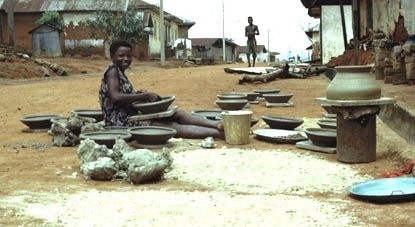 |
Girl making clay pottery. Mpraeso, Kwawu. Fresh clay from riverside.
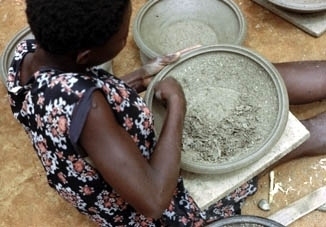 |
No wheel. Tools are sticks and stones on ground on her right side.
The clay is full of bauxite and iron oxide. It becomes red when fired.
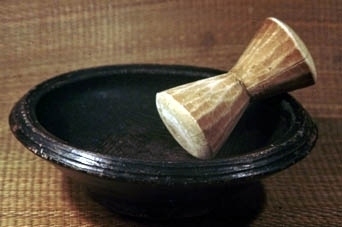 |
Mpayewa (Grinding Bowl).
The mpayewa is shown here with a wooden spool for grinding vegetables into a purée. Wood working such as this done mainly by men.
Wet leaves in kiln make the outside of the bowl black. This one has serrated bottom and is used as a blender (grinder).
 |
Obomen; grinding vegetables
When used as a blender or grinder, the movement of the hand is too fast for this camera to catch it.
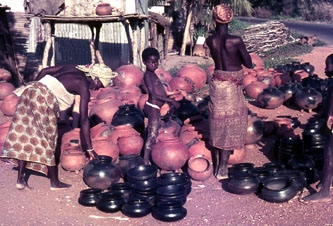 |
Road Side Pottery Market
Funeral Dolls:
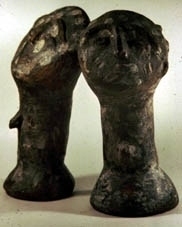 |
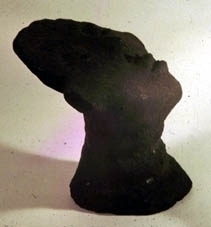 |
Note the similarity with fertility dolls (High forehead, rings around the neck). Those dolls are made by men, and are wooden. These are made of clay by women. Like the bowls and pots, terracottas are blackened during firing by putting wet leaves in the kiln.
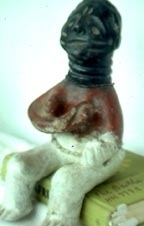 |
An unusual terracotta. A local god
While the usual terracotta clay objects made by women are representations of dead persons, I came across one interesting exception. Above is the depiction of a local god (because of my promise not to reveal secrets, I am not able to identify the name of this god). The god has various personalities (as do most local deities), the older ones of which speak Guan. If you read Three Souls, the significance of the three colours may be more apparent. Black is directly from god, transition, destiny. Red is female, nurturing, feeding, fecundity. White is for morals, male, sex, strength, personality. The high forehead and rings around the neck are typical signs of beauty.
House Walls:
Another page has been used to illustrate houses. Look there to see how clay is used to plaster the outside of houses.
Instead of a surface of clay, most new houses are painted with commercial paints.
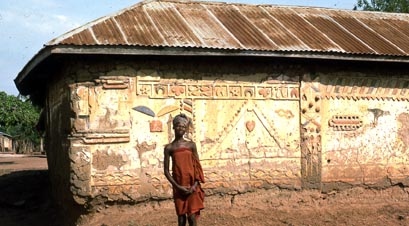 |
Only a few old houses still have the raised decorations
An historical document dated 1910 describes the Chief's house in Obo as having decorations raised from the surface like this, but they have long gone, and are now painted over with commercial paint.
- Gender Hub
- Gender Introduction
- Gender Commensality ; Gender II
- Women I; Food
- Women II; Farming
- Women III (1): Cooking
- Women III (2): Cooking 2
- Women IV: Marketing
- Women V: Clay
- Men I: Wood
- Men II: Weaving
- Men III: Hunting
- Men IV: (1) Transport
- Men IV: (2) Transport
- Men and Women; (1) Oil Palm; Introduction
- Men and Women; (2) Oil Palm; Farming, Oil
- Men and Women; (3) Oil Palm; Wine Tapping
- Men and Women; (4) Oil Palm; Wine Marketting
- Men and Women; (5) Oil Palm; Other Products
- Men and Women; (1) Oil Palm; Conclusion